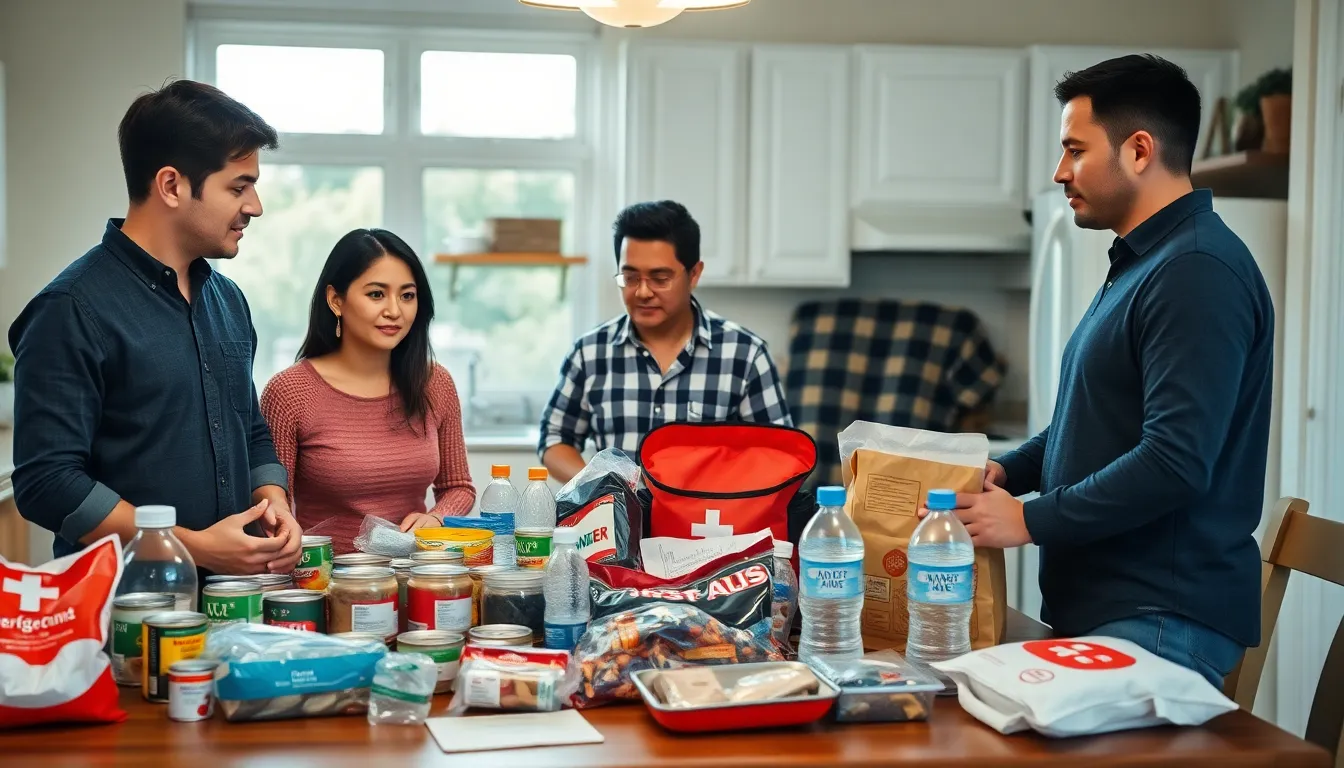Table of Contents
ToggleWhen the world feels like a scene from a disaster movie, having a solid outbreak survival guide can make all the difference. Picture this: you’re holed up at home, binge-watching your favorite series, while the outside world spirals into chaos. But don’t panic! With the right prep and a dash of humor, you can navigate through the madness like a pro.
This guide isn’t just about stockpiling toilet paper and canned beans. It’s about smart strategies that keep you safe, sane, and maybe even a little entertained. From essential supplies to maintaining your mental health, it’s time to turn that frown upside down and embrace your inner survivalist. So grab your favorite snack and let’s dive into the essentials that’ll help you weather any storm—because who says survival can’t be a little fun?
Overview of Outbreaks
Understanding outbreaks is vital for effective preparedness. They arise when diseases spread rapidly in communities. Various factors contribute to these outbreaks, including environmental changes, population density, and public health measures. Infectious agents, such as viruses, bacteria, and parasites, trigger these health crises.
Common types of outbreaks include seasonal flu, norovirus, and pandemic situations like COVID-19. Flu outbreaks occur typically in winter months, affecting millions each year. Norovirus outbreaks often stem from contaminated food or water, leading to widespread gastrointestinal illnesses. In contrast, global pandemics can result in unprecedented responses and long-lasting societal impacts.
The World Health Organization reported over 1,000 disease outbreaks in 2019 alone. Recognizing symptoms early can limit the spread of illness. Fever, cough, and fatigue often signify the onset of more serious health threats. Communities stay safer when health education is prioritized, enabling individuals to identify and report unusual health trends promptly.
Additionally, outbreak response plans play a crucial role in controlling spread. These plans typically include vaccination strategies, public awareness campaigns, and resource allocation for healthcare facilities. Collaboration between individuals, health organizations, and governments enhances overall public health readiness.
Health professionals emphasize the significance of hygiene and sanitation during outbreaks. Simple actions like handwashing and proper food handling reduce transmission rates. By promoting community awareness, individuals can foster a culture of safety and resilience during challenging times. Preparation involves not just physical supplies but also knowledge and community engagement strategies.
Preparing for an Outbreak

Preparation is crucial during outbreaks. It extends beyond supplies, encompassing effective planning and strategy.
Essential Supplies to Gather
Maintain a well-rounded supply stock. Focus on non-perishable foods such as canned vegetables, rice, and protein sources. Keep drinking water available; one gallon per person daily is a common guideline. Include first aid supplies like bandages, antiseptics, and over-the-counter medications. Personal hygiene products include soap, hand sanitizer, and toilet paper. Don’t forget essential items for pets if applicable. Flashlights and batteries ensure safety during power outages. Gathering these supplies ahead minimizes risk during uncertain times.
Creating an Emergency Plan
Crafting a solid emergency plan aids preparedness. Identify a designated meeting place for family members, ensuring everyone understands where to go during a crisis. Designate specific roles for each family member, detailing responsibilities like communication and supply management. Develop a communication strategy; utilize phone trees or group messaging to check in on each other. Ensure that everyone knows emergency contacts, including local health resources. Regularly review and practice the plan to enhance confidence and efficiency. Adopting this proactive approach fosters a sense of security and readiness.
Survival Strategies During an Outbreak
These strategies enhance safety and well-being during an outbreak. Individuals can adopt specific practices to navigate through challenging situations.
Maintaining Hygiene and Sanitation
Proper hygiene significantly reduces the risk of infection. Frequent handwashing with soap and water for at least 20 seconds is essential. When soap isn’t available, using hand sanitizer with at least 60% alcohol offers adequate protection. Disinfecting surfaces that receive high contact, like doorknobs and kitchen counters, helps minimize germs. Individuals should also avoid crowded places to decrease exposure to pathogens. Wearing masks in public settings might protect both oneself and others from spreading illness. Keeping personal items separate, especially in shared living spaces, ensures a lower chance of contamination. Regularly emptying trash and maintaining cleanliness contributes to a healthier environment.
Communication and Staying Informed
Staying informed is crucial during any outbreak. Reliable sources, such as the Centers for Disease Control and Prevention and the World Health Organization, offer up-to-date information. Checking alerts from local health departments helps individuals respond quickly to changing situations. Sharing accurate information with friends and family fosters a supportive community during crises. Designating a family spokesperson ensures clear communication, especially when discussing plans and updates. Engaging in community discussions amplifies awareness about safety protocols. Utilizing online platforms for real-time updates enables better preparedness. Every effort to stay connected increases individual and collective resilience during an outbreak.
Mental Health Considerations
Maintaining mental health during an outbreak proves essential. Stress and anxiety can escalate without proper strategies.
Coping with Stress and Anxiety
Individuals often experience heightened stress and anxiety during outbreaks. Regular exercise helps alleviate tension and improve mood. Engaging in mindfulness practices, such as deep breathing, can provide immediate relief. Setting aside time for hobbies, like reading or painting, fosters relaxation. Limiting exposure to news can reduce feelings of overwhelm. It’s beneficial to establish a daily routine to create a sense of normalcy. Incorporating balanced nutrition further supports mental well-being. Seeking professional help, if needed, remains a proactive choice.
Staying Connected with Others
Social connections serve as a vital support system during outbreaks. Using technology allows individuals to stay in touch with friends and family. Virtual gatherings, such as video calls, can replace traditional meetups. Sharing feelings with others cultivates a sense of community. Engaging in online support groups provides additional emotional resources. Creative communication methods, like sending letters or postcards, strengthen bonds. Communities play a significant role in reinforcing collective resilience. Prioritizing connections enhances mental health and combats feelings of isolation.
Post-Outbreak Recovery
Post-outbreak recovery focuses on restoring normalcy and strengthening community resilience. Individuals often encounter physical and mental health challenges during this phase, making it essential to prioritize both aspects.
Physical health recovery starts with assessing any lingering symptoms or health issues. Seeking professional medical advice ensures effective treatment plans and facilitates better health outcomes. Nutritional support plays a critical role; consuming balanced meals helps rebuild strength and immunity. Engaging in regular physical activity enhances overall wellness, aiding both recovery and emotional stability.
Mental health is equally important in post-outbreak recovery. Stress and anxiety can persist long after an outbreak. Utilizing coping strategies like mindfulness practices or journaling can foster emotional processing. Connecting with support networks, whether through community groups or online platforms, bolsters feelings of belonging and understanding.
Communities may also initiate recovery programs to support collective healing. Local organizations can offer resources such as counseling services and health workshops. Collaborative efforts in neighborhoods strengthen social ties, helping resolve feelings of isolation.
Prioritizing open communication remains crucial during recovery. Sharing experiences fosters understanding and helps communities cope. Community forums or discussions create safe spaces for individuals to express concerns and suggest recovery initiatives.
Finally, resilience becomes a collective goal in post-outbreak environments. Engaging in community planning, focusing on prevention strategies for future outbreaks, and investing in health education ensures preparedness. This proactive approach cultivates a culture of safety and awareness, readying individuals and communities for potential challenges ahead.
Navigating an outbreak requires more than just supplies; it demands a well-rounded approach to safety and well-being. By prioritizing preparation and fostering community engagement individuals can enhance their resilience. Embracing smart strategies for hygiene mental health and communication paves the way for a more secure environment.
As they work through the challenges of an outbreak maintaining a positive outlook and staying informed is essential. The journey doesn’t end with survival; it extends into recovery and rebuilding. By focusing on both physical and mental health communities can emerge stronger and more united ready to face future challenges together.




